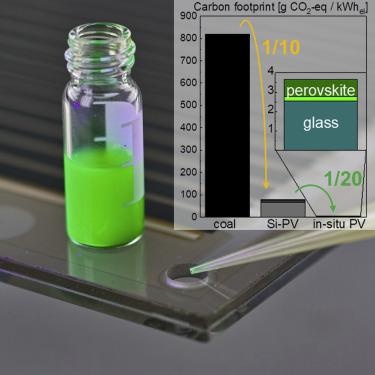Joule ( IF 38.6 ) Pub Date : 2020-03-02 , DOI: 10.1016/j.joule.2020.02.001 Lukas Wagner , Simone Mastroianni , Andreas Hinsch

|
Although it still contributes to less than 2% of the worldwide electricity generation, photovoltaics (PVs) is on the way to becoming a key energy technology for a global future renewable energy infrastructure. We present projections of worldwide CO2 emissions of the future PV industry, finding that these emissions will likely surpass those caused by the global shipping or aviation sector. As an alternative, we propose a fully printed PV reverse manufacturing concept that minimizes the carbon footprint to the ultimate lower limit of the glass substrate fabrication. This so called “in situ” approach is based on a perovskite absorber that is highly durable and encapsulated with glass solder between float glass substrates, reducing the CO2-footprint of conventional PV modules by 1/20th. Yielding a certified stabilized efficiency of 9.3%, this record efficiency for glass-solder-encapsulated perovskite PV paves the way for future solar cells with the lowest carbon footprints.
中文翻译:

逆向制造使钙钛矿光伏技术达到玻璃基板的碳足迹极限
尽管它仅占全球发电量的不到2%,但光伏(PVs)正在成为全球未来可再生能源基础设施的关键能源技术。我们对未来光伏行业的全球CO 2排放量进行了预测,发现这些排放量可能会超过全球航运或航空业造成的排放量。作为替代方案,我们提出了完全印刷的PV逆向制造概念,该概念可将碳足迹最小化至玻璃基板制造的最终下限。这种所谓的“原位”方法是基于钙钛矿吸收剂,该吸收剂具有很高的耐用性,并在浮法玻璃基板之间用玻璃焊料封装,从而减少了CO 2。通过1/20 -footprint常规PV模块的第。经认证的稳定效率为9.3%,这种创纪录的玻璃焊料封装钙钛矿PV效率为未来具有最低碳足迹的太阳能电池铺平了道路。











































 京公网安备 11010802027423号
京公网安备 11010802027423号